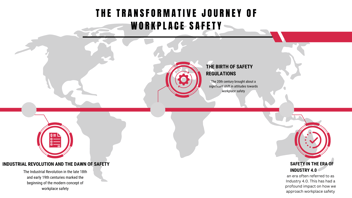5 Reasons you’re at risk with Traditional Safety Management
Here are 5 reasons why traditional safety management is failing, and how to reverse it.
Safety as an Objective!
Despite the extensive knowledge gained by professional safety management over the past century in accident prevention, the evidence suggests that safety programs can still be highly ineffective. Unfortunately, there have been numerous instances that demonstrate this reality, a report from the General Organization for Social Insurance (GOSI) has recorded a number of 28,227 work injuries in the year 2022 in Saudi Arabia.
According to the report the injuries by sector is as follows:
- The construction sector was the highest in recording with 9,607 injuries
- The manufacturing sector with 6,600 injuries
- The wholesale and retail sector had 3,664 injuries
Investigations into these tragic events have uncovered a common issue: despite claims of a commitment to safety from management, the pressures of production, whether real or perceived, can override any safety program. This is because safety is often viewed as a requirement for a company rather than an objective. This can result in companies failing to prioritize safety when it is most crucial, with employees bearing the brunt of the consequences.
In this article we will look at 5 reasons why traditional safety management puts your organization at risk in occupational health and safety of your employees and how an integrated safety management system can not only help mitigate these risks, manage costs but also promote a dynamic safety culture for all.
Reactive Approach
The reactive approach to safety management can have several negative consequences. The approach focuses only on reacting to incidents after they have occurred, meaning hazards may not be identified and addressed until it is too late. This can result in more severe incidents and injuries, higher costs, and damage to the organization's reputation.
A culture of blame and punishment can discourage employees from reporting safety issues, leading to underreporting of incidents and a lack of trust between employees and management. Therefore, missing out on opportunities for identifying and mitigating hazards, as well as a failure to learn from past incidents and improve safety performance.
Lack of Employee Involvement
A lack of employee involvement in safety management can lead to disengagement and a lack of ownership among employees. When employees are not involved in the decision-making process, they may feel that their opinions and experiences are not valued, which can lead to a lack of motivation to participate in safety initiatives. A top-down approach to decision-making can also result in policies that are impractical or unrealistic, leading to a lack of trust in management and a failure to implement effective safety measures.
Limited Scope
Focusing only on compliance with regulatory requirements and safety standards can result in a narrow view of safety, which fails to take into account the complex and dynamic nature of safety hazards and risks. Organizations may become complacent, believing that they are meeting safety requirements when, in reality, they are not addressing all the hazards and risks in their workplace.
This limited scope for standards and requirements may induce a false sense of security for workers and managers. A compliance-focused approach can also lead to a lack of innovation and creativity in addressing safety issues, as organizations may not prioritize finding new and better ways to improve safety outcomes.
Inadequate Safety Metrics
Relying solely on lagging indicators such as injury and incident rates can be an inadequate way to measure safety performance. These metrics only provide a backward-looking view of safety and may not capture all safety hazards and risks in the workplace.
Inadequate safety metrics can result in a failure to identify potential hazards before an incident occurs and a lack of insight into the effectiveness of safety initiatives. In addition, relying solely on lagging indicators can lead to a focus on reactive measures rather than proactive measures to prevent incidents from occurring.
Resistance to Change
Resistance to change in safety management can have several negative consequences. Firstly, it can result in a failure to adopt new technologies or approaches that could improve safety performance and reduce risks. This can lead to missed opportunities for improving safety outcomes and remaining competitive in the marketplace.
Resistance to change can create a culture of complacency, where organizations become stuck in their ways and fail to seek out new and innovative ways to improve safety outcomes. Resistance to change can also result in a failure to address emerging safety hazards and risks, as organizations may not be proactive in identifying and mitigating new threats.
Moving Forward with Safety
The traditional approach to safety management can put your organization at risk and fail to provide a comprehensive view of safety hazards and risks. To break away from traditional safety management and adopt a more forward-thinking approach, businesses should take these necessary steps:
- Prioritize proactive safety measures: Instead of waiting for incidents to occur, take proactive steps to identify and address potential safety risks.
- Foster a safety culture: Encourage open communication and collaboration among employees and promote a shared responsibility for safety.
- Use data analytics: Analyze safety data to identify trends, anticipate potential issues, and make informed decisions.
- Embrace new technology: Adopt emerging technologies such as wearables, sensors, and automation to enhance safety and efficiency.
- Implement integrated digital solutions: Integrate digital solutions to create a more connected and streamlined safety management system. Use real-time data and analytics to continuously improve safety processes.
By following these key principles, businesses can break away from traditional safety management and adopt a more forward-thinking approach that incorporates digital solutions. This will not only enhance safety but also improve productivity and drive business success.
An integrated safety management solution as an HSSE platform can help mitigate risks, manage costs, and promote a dynamic safety culture for all. A HSSE platform like HodHod provides real-time data on safety performance, including leading indicators such as safety observations and hazard identification, allowing organizations to make data-driven decisions and measure the effectiveness of safety initiatives.


